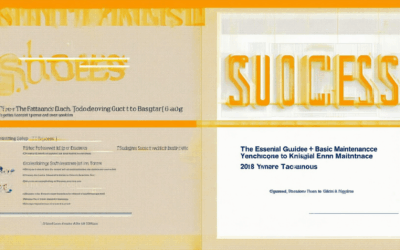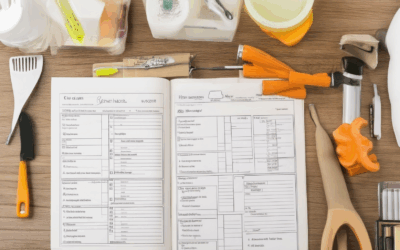Seasonal changes bring unique challenges to maintaining vehicles and homes, requiring tailored schedules to ensure everything runs smoothly year-round. Whether it’s preparing cars for winter roads or homes for spring cleaning, staying ahead of repair needs is crucial for longevity and efficiency. This guide dives into crafting a personalized seasonal repair schedule, offering essential frequency guidelines for cars and homes. From weekly checks to annual inspections, discover how to create a maintenance plan that fits your lifestyle. Explore examples of routine repairs, learn how often homes need repairs, and access detailed checklists and PDF downloads to stay organized. With this comprehensive approach, you’ll master the art of seasonal maintenance, ensuring your property remains in top shape all year long.
Key Takeaways
- Home Maintenance Essentials: Conduct monthly checks on exterior surfaces, gutters, and safety devices; perform quarterly thorough inspections; tackle seasonal tasks like weather preparation and outdoor equipment servicing; and address annual projects such as roofing, deck repairs, and appliance servicing.
- Car Care Guidelines: Follow a structured mileage-based maintenance schedule to ensure your vehicle operates efficiently and avoids costly repairs.
- Budgeting for Repairs: Implement the 1% rule to allocate annual maintenance funds, adjusting for increasing needs as your home ages.
- DIY and Professional Help: Use DIY guides and checklists for basic tasks; seek professional assistance when challenges arise.

What is the schedule for car maintenance and repair?
The optimal car maintenance schedule varies by vehicle make and model, but most manufacturers recommend a 30-60-90 mile maintenance interval. This approach ensures that critical components are checked and serviced at recommended milestones.
Key Maintenance Intervals Explained
- 30,000 Miles: Replace oil and oil filter, inspect belts, hoses, and brakes, check tire pressure, and perform a general visual inspection of the vehicle’s undercarriage.
- 60,000 Miles: Replace engine oil and filter, inspect suspension components, check braking system, and test battery function. Additionally, replace spark plugs and air filter if applicable.
- 90,000 Miles: Conduct a thorough inspection, including transmission fluid replacement, differential oil change, and coolant flush. Replace wiper blades and review owner’s manual recommendations for specific needs.
Additional Tips for Car Care
- Regularly check fluid levels, including coolant, brake fluid, and transmission fluid.
- Replace worn-out parts promptly to prevent further damage or costly repairs.
- Inspect tires for wear, cracks, or low tread levels and rotate them as needed.
- Book a professional inspection at least once a year or before major trips.
Resources for Further Information
For detailed guidelines tailored to your vehicle, consult your owner’s manual or trusted automotive service center. Sams Maintenance provides comprehensive car care tips and resources to help you maintain your vehicle effectively. Explore our guides and DIY projects for more insights: Car Maintenance Guides .
Conclusion
Following a consistent maintenance schedule is crucial for extending your car’s lifespan and ensuring reliability. Prioritize routine checks and services to avoid unexpected breakdowns. Trust Sams Maintenance for expert advice and reliable car care solutions. Keep your vehicle running smoothly with our professional maintenance services and resources.
What is an example of a routine repair?
Routine repairs are essential tasks needed to maintain the integrity and functionality of your home. Here are some common examples:
-
Gutter and Downpipe Cleaning and Repair
Gutters and downpipes often get clogged with debris like leaves and dirt. Cleaning them regularly prevents water overflow and damage to your roof or foundation. Repairs may include fixing leaks or loose connections.
-
Door and Window Adjustments
Over time, doors and windows may become stuck or difficult to open. Routine adjustments like lubricating hinges or re-fitting sashes can prevent costly replacements.
-
Plasterwork Repairs
Cracks or peeling paint in walls or ceilings can indicate underlying issues. Repairs may involve patching holes or applying fresh coats of paint to maintain a smooth finish.
-
Flooring Maintenance
Regularly inspecting and maintaining flooring, whether it’s tiles, wood, or carpet, helps prevent wear and tear. Fixes could include replacing loose tiles or deep cleaning carpets.
-
Appliance Checks
Ensuring appliances like refrigerators, ovens, and HVAC systems are functioning properly is crucial. This includes regular inspections and minor repairs to prevent major breakdowns.
Sams Maintenance offers comprehensive resources to help homeowners manage these routine repairs efficiently. From DIY guides to professional advice, we’re here to keep your home in top shape. Learn more about our maintenance services .
Competitors like Home Depot and Lowe’s also offer similar services, so it’s worth checking reviews and prices to find the best fit for your needs. Explore Home Depot’s offerings or visit Lowe’s online for more options.

How to Create a Maintenance Schedule
To create an effective maintenance schedule, follow these organized steps:
1. Categorize Maintenance Tasks
- Monthly Maintenance: Regular tasks that ensure systems run smoothly. Examples include checking smoke detectors, watering plants, and cleaning gutters.
- Quarterly Tasks: More extensive checks, such as inspecting the roof, testing appliances, and pruning trees.
- Annual Inspections: Comprehensive reviews of major systems like HVAC, plumbing, and electrical components.
- Seasonal Adjustments: Tasks tailored to the time of year, like lawn mowing in spring or winterizing pipes in fall.
2. Determine Task Frequency
- Assign tasks based on their necessity and frequency to avoid overwhelming yourself.
- Create a checklist for each category to ensure nothing is missed during each scheduled maintenance.
3. Prioritize and Group Tasks
- Group similar tasks together, such as tackling lawn care and pressure washing in early spring before moving on to larger projects.
- Plan larger tasks around weather conditions, like waiting until after frost for garden work.
4. Utilize Tools and Resources
- Invest in essential tools like a sturdy ladder, flashlight, or multimeter for safety and efficiency.
- Refer to detailed guides or checklists available online for specific tasks, such as Sams Maintenance guides .
5. Stay Consistent and Flexible
- Stick to your schedule to maintain peak performance of your home systems.
- Adjust tasks as needed based on changes in your lifestyle or home environment.
Example Maintenance Schedule
| Month | Tasks |
|---|---|
| January | Check HVAC filter, test fire extinguishers, organize storage spaces |
| February | Inspect pipes for leaks, prune trees, check smoke detector batteries |
| March | Lawn mowing, pressure washing, check for dead tree branches |
| April | Garden cleanup, fence inspection, clean out gutters |
6. Resources and Further Reading
- For detailed maintenance guides, visit Sams Maintenance Tips .
- Explore additional resources on Sams Maintenance Blog for expert advice.

How Often Should Home Maintenance Tasks Be Performed?
To maintain your home in optimal condition, regular maintenance is essential. Here’s a breakdown of recommended frequencies for common tasks:
- Monthly Checks:
- Inspect exterior surfaces (e.g., siding, windows) for damage.
- Check gutters and downspouts for clogs and leaks.
- Examine caulking around windows and doors for cracks.
- Test smoke detectors and carbon monoxide alarms.
- Quarterly Inspections:
- Perform a full home inspection, including attic, crawl spaces, and appliance function.
- Check foundation for cracks or shifts.
- Service HVAC systems and change air filters.
- Inspect plumbing for leaks and water pressure.
- Seasonal Tasks:
- Prepare for extreme weather (e.g., winterize pipes, secure gutters).
- Prune trees and trim shrubs.
- Service outdoor equipment (mowers, lawn care tools).
- Annual Projects:
- Replace worn-out roofing materials.
- Inspect and replace deck boards or stairs.
- Service major appliances (dishwashers, ovens, HVAC systems).
- Check fireplaces and chimneys for safety.
For a smoother experience, consider setting reminders for these tasks. Regular maintenance not only extends your home’s lifespan but also ensures safety and comfort. Explore our DIY Guides for step-by-step solutions and professional tips. If you notice significant issues, consult with licensed contractors or experts from trusted services like Local Inspector Network .
What is a Good Maintenance Schedule?
A well-planned maintenance schedule ensures your property remains in excellent condition year-round. Here’s a comprehensive guide to creating an effective routine:
Mileage-Based Maintenance Schedule
Regular maintenance should be performed at intervals based on mileage, typically following a 30-60-90-120-150-180-210-240-300-360-420-500-mile schedule:
- 30 Miles: Initial inspection, fluid checks, and basic cleaning.
- 60 Miles: Oil change, filter replacement, and tire pressure check.
- 90 Miles: Brake system inspection, belt tension check, and fluid level top-up.
- 120 Miles: Air filter replacement, cooling system inspection, and battery test.
- 150 Miles: Fuel system cleaning, spark plug inspection, and exhaust system check.
- 180 Miles: Transmission fluid check, differential inspection, and suspension examination.
- 210 Miles: Heater and AC system inspection, interior cleaning, and door lock lubrication.
- 240 Miles: Brake pad replacement (if needed), steering rack inspection, and wiper blade replacement.
- 300 Miles: Full vehicle inspection, engine compression test, and coolant flush.
- 360 Miles: Battery replacement, alternator check, and fuel tank cleaning.
- 420 Miles: Oil and filter service, suspension adjustment, and wheel alignment.
- 500 Miles: Final inspection, tire rotation, and brake system overhaul.
Stick to this schedule to prevent costly repairs and ensure your vehicle runs efficiently. Regular maintenance helps extend the life of your car and maintains its performance. For more detailed guides and tools, visit our home maintenance resources .

How Often Do Homes Need Repairs?
A home requires routine repairs and maintenance to preserve its value and functionality. According to the 1% rule suggested by John Ghent, a $100,000 home should budget approximately $1,000 annually for maintenance. This rule helps homeowners understand the expected costs over time.
The 1% Rule Breakdown
Here’s a phase-by-phase breakdown of home maintenance costs:
- First 10 Years : 0.75% of the home’s value annually.
- Next 10 Years : 1.5% annually.
- Third 10 Years and Beyond : 3% annually.
This gradual increase reflects the aging of home components and rising maintenance needs.
Practical Tips for Homeowners
To manage repair costs effectively: – Schedule annual inspections for systems like HVAC, plumbing, and roofing. – Replace worn-out materials promptly to prevent costly damage. – Consider energy-efficient upgrades for long-term savings.
For detailed guidance, consult Sams Maintenance’s home maintenance checklist and repair guides .
Competitor Resources
Explore additional resources from trusted competitors:- Fixer Upper’s Maintenance Tips – HouseOlogy’s Repair Guide
By understanding these guidelines, homeowners can better prepare for unexpected repair costs and extend their home’s lifespan. Regular maintenance is key to preserving your investment.




0 Comments